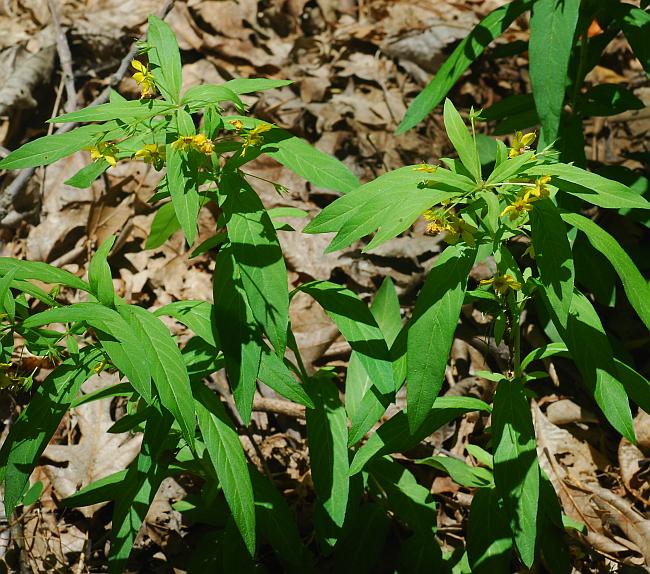Lysimachia lanceolata Walter
Loosestrife

Native
CC = 4
CW = 0
MOC = 52
© SRTurner
Lysimachia lanceolata WalterLoosestrife | |
 |
Native CC = 4 CW = 0 MOC = 52 |
© SRTurner |
|
Family - Primulaceae Habit - Perennial forb with elongate, slender rhizomes. Stems - Ascending to erect, to 80 cm, relatively slender (1-2 mm in diameter at the base), erect or strongly ascending, usually short-branched above the midpoint, glabrous or minutely glandular-hairy around the upper nodes.
Leaves - Basal and lower stem leaves sometimes persistent at flowering, smaller than the median stem leaves. Stem leaves opposite or whorled, the lowermost ones usually with a relatively well-defined petiole 0.5-1.5 cm long, the petioles progressively shorter and less well-defined toward the stem tip, the uppermost leaves often appearing essentially sessile. Petioles somewhat flattened, narrowly winged, the margins pubescent with long, spreading hairs below the midpoint, the pubescence sparse or absent toward the tip. Leaf blades 3-14 cm long, 0.7-2.0 cm wide, sometimes more or less folded lengthwise along the midvein, those of the lowermost leaves ovate to narrowly obovate or elliptic-lanceolate, becoming progressively narrower toward the stem tip, the uppermost leaf blades often linear to narrowly lanceolate, the bases accordingly rounded to angled or tapered, angled or somewhat tapered to a sharply pointed tip, the margins entire or more commonly roughened with minute papillae, the surfaces lacking glandular dots, not punctate, glabrous, the upper surface green to dark green, the undersurface light green; secondary veins evident.
Inflorescences - Axillary from the uppermost nodes, of solitary flowers, the flower stalks 2.0-4.5 cm long, arching, glabrous. Flowers often held spreading or drooping.
Flowers - Calyces mostly 5-lobed, the lobes 4-7 mm long, lanceolate, not gland-dotted or punctate, usually with 1-3 faint veins. Corollas mostly 5-lobed, the lobes 5-10 mm long, obovate to oblong-obovate, broadly rounded or truncate but usually with a minute to somewhat elongate sharp point at the tip, the margins sometimes somewhat uneven or irregularly toothed, yellow, densely glandular and with reddish markings on the upper surface toward the base, lacking purple spots or lines. Stamens 5, shorter than the corollas, the filaments 2-3 mm long, not fused into a basal tube, glandular-hairy. Staminodes alternating with the stamens, slender or somewhat broadened toward the base. Ovary superior, green, glabrous, ovoid to globose, 1.3 mm in diameter, unilocular. Placentation free-central. Styles white, glabrous, 3-4 mm long.
Fruits - Capsules 3.0-4.5 mm long, broadly ovoid to globose. Seeds 1.2-1.8 mm long, irregularly elliptic, oblong, or rhombic in outline, triangular in cross-section, dark brown to black. Flowering - May - August. Habitat - Streambanks, pond margins, acid seeps, bottomland and mesic forests, prairies, glades, pastures, railroads, and roadsides. Origin - Native to the U.S. Lookalikes - Other species of Lysimachia, especially L. ciliata, L. hybrida. Other info. - This little species is found mainly in the eastern and southern regions of Missouri, being uncommon or absent in the northwestern quadrant of the state. Beyond Missouri its range extends throughout most of the eastern half of the continental U.S. and into Canada. It is not particularly showy, since the flowers almost never point up, but rather sideways or downwards. Plants in the genus are recognized by their distinctive flowers having reddish markings toward the centers and apiculate tips on the petals. Distinction of this species from its lookalikes is somewhat subtle, and is indicated by the plant's relatively short stature, narrow leaves which are paler on the underside, and long slender rhizomes. Photographs taken on Stegal Mountain, MO., 6-17-03 (DETenaglia); also at Grasshopper Hollow, Reynolds County, MO, 6-15-2013 and 6-20-2022; and Engelmann Woods Natural Area, Franklin County, MO, 6-17-2016. |